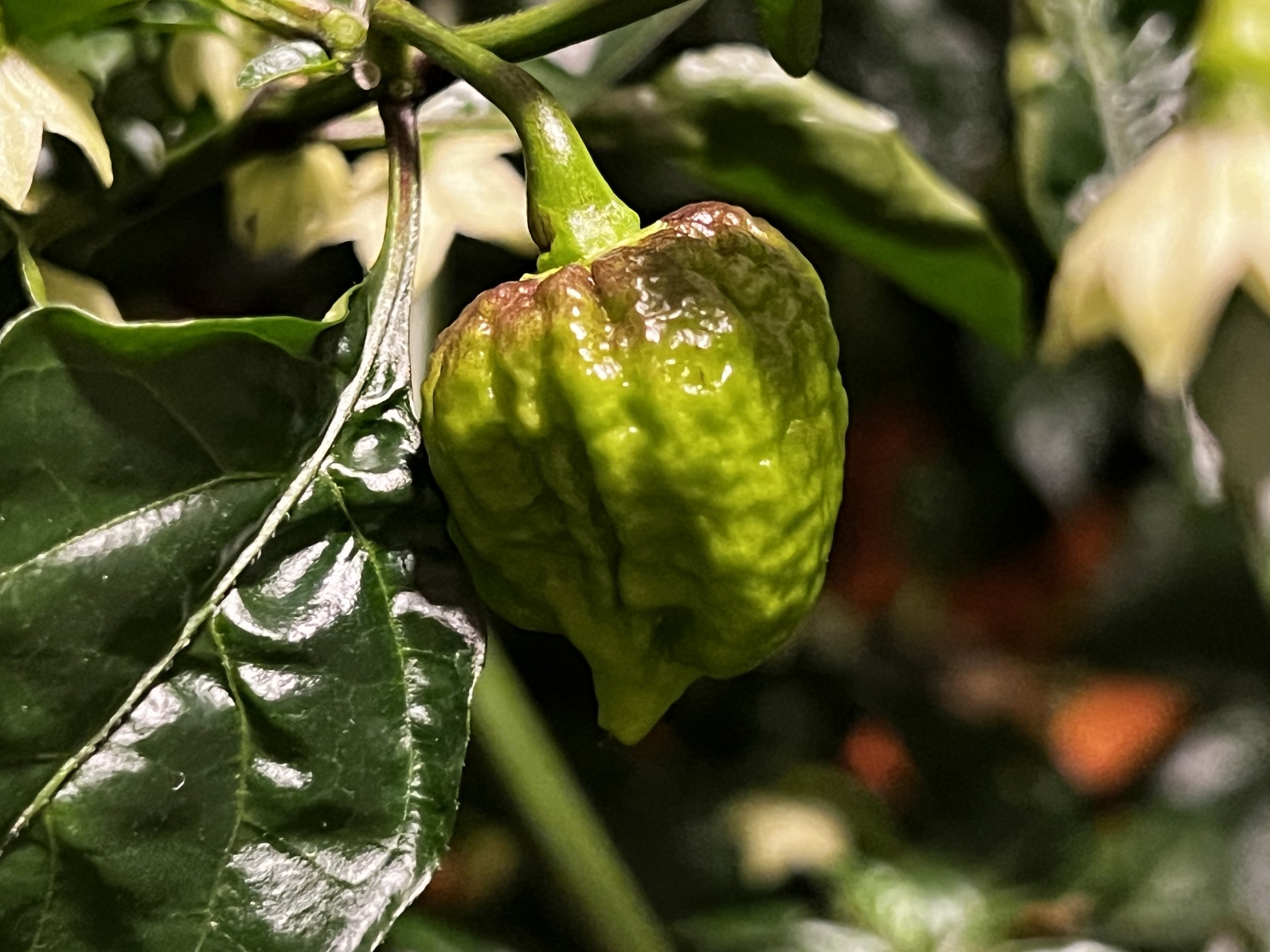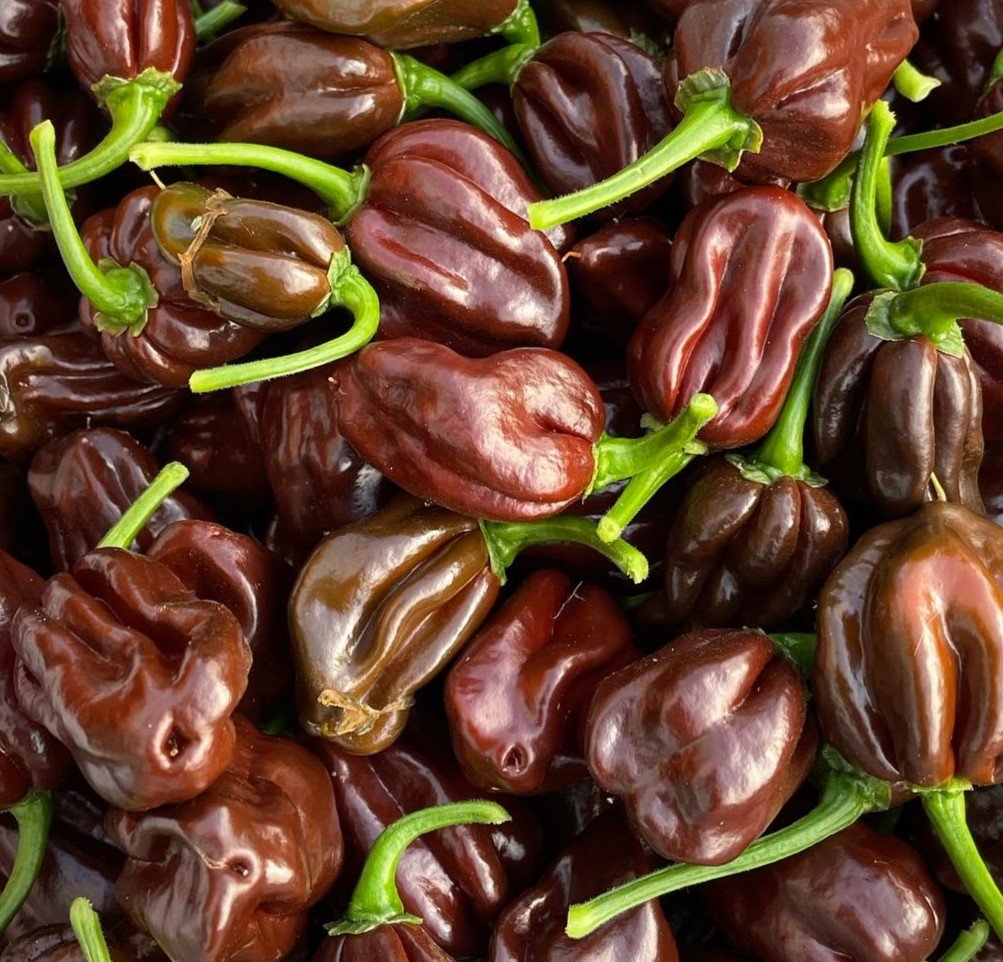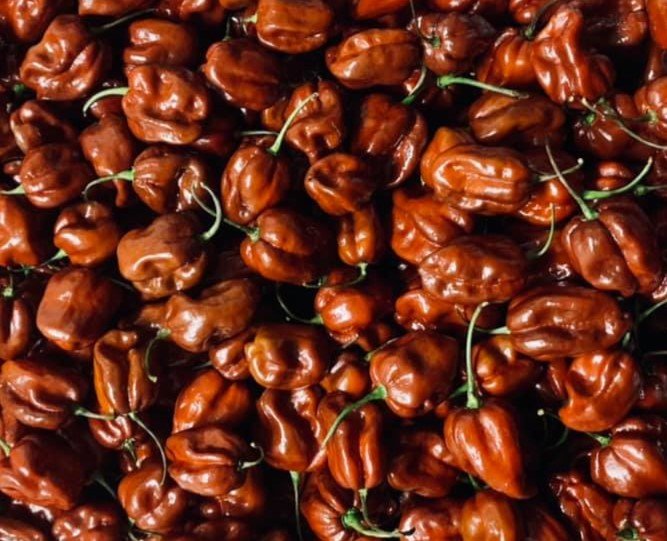Ghost Pepper (Bhut Jolokia) Seeds
Ghost peppers, also known as Bhut Jolokia, are one of the world's hottest chili peppers. They originate from the Assam region in northeastern India and have gained international recognition for their extreme spiciness. Here are some key details about ghost peppers:
Scoville Heat Units (SHU): Ghost peppers have an average Scoville Heat Unit rating ranging from 800,000 to 1,041,427 SHU, although some individual peppers have been recorded at over a million SHU. To put this in perspective, they are several times hotter than the more common habanero pepper and even hotter than many other super-hot chili peppers.
Appearance: Ghost peppers typically measure 2.5 to 3.3 inches in length and have a wrinkled, rough, and somewhat lumpy skin. They start off green and ripen to a vibrant red color.
Flavor: Ghost peppers have a fruity and slightly sweet flavor, but this is often masked by their intense spiciness. The heat level can be overwhelming, making them suitable for those who enjoy extremely spicy foods.
Culinary Use: Ghost peppers are used sparingly in cooking due to their extreme spiciness. They can be added to various dishes, such as curries, hot sauces, salsas, and pickles, to add a potent kick. Just a small amount of ghost pepper can significantly increase the heat of a dish.
Handling Precautions: When working with ghost peppers, it's essential to take safety precautions. It's advisable to wear gloves and avoid touching your face, especially your eyes, as the capsaicin in these peppers can cause intense irritation. Proper ventilation is also crucial when cooking with ghost peppers, as the fumes can be potent.
Health Benefits: Some studies suggest that capsaicin, the compound responsible for the heat in ghost peppers, may have potential health benefits, such as pain relief and metabolism stimulation. However, consuming ghost peppers in excessive amounts can be harmful and lead to digestive discomfort.
Popularity: Ghost peppers have become popular in recent years among chili enthusiasts, and they have even been used in competitive eating challenges.
It's essential to be cautious when using ghost peppers in your cooking, and start with very small quantities until you become familiar with their heat level. They can add a unique and fiery dimension to your dishes, but they should be approached with respect for their intense spiciness.
*1 pack is ~12 seeds*
Ghost peppers, also known as Bhut Jolokia, are one of the world's hottest chili peppers. They originate from the Assam region in northeastern India and have gained international recognition for their extreme spiciness. Here are some key details about ghost peppers:
Scoville Heat Units (SHU): Ghost peppers have an average Scoville Heat Unit rating ranging from 800,000 to 1,041,427 SHU, although some individual peppers have been recorded at over a million SHU. To put this in perspective, they are several times hotter than the more common habanero pepper and even hotter than many other super-hot chili peppers.
Appearance: Ghost peppers typically measure 2.5 to 3.3 inches in length and have a wrinkled, rough, and somewhat lumpy skin. They start off green and ripen to a vibrant red color.
Flavor: Ghost peppers have a fruity and slightly sweet flavor, but this is often masked by their intense spiciness. The heat level can be overwhelming, making them suitable for those who enjoy extremely spicy foods.
Culinary Use: Ghost peppers are used sparingly in cooking due to their extreme spiciness. They can be added to various dishes, such as curries, hot sauces, salsas, and pickles, to add a potent kick. Just a small amount of ghost pepper can significantly increase the heat of a dish.
Handling Precautions: When working with ghost peppers, it's essential to take safety precautions. It's advisable to wear gloves and avoid touching your face, especially your eyes, as the capsaicin in these peppers can cause intense irritation. Proper ventilation is also crucial when cooking with ghost peppers, as the fumes can be potent.
Health Benefits: Some studies suggest that capsaicin, the compound responsible for the heat in ghost peppers, may have potential health benefits, such as pain relief and metabolism stimulation. However, consuming ghost peppers in excessive amounts can be harmful and lead to digestive discomfort.
Popularity: Ghost peppers have become popular in recent years among chili enthusiasts, and they have even been used in competitive eating challenges.
It's essential to be cautious when using ghost peppers in your cooking, and start with very small quantities until you become familiar with their heat level. They can add a unique and fiery dimension to your dishes, but they should be approached with respect for their intense spiciness.
*1 pack is ~12 seeds*
Ghost peppers, also known as Bhut Jolokia, are one of the world's hottest chili peppers. They originate from the Assam region in northeastern India and have gained international recognition for their extreme spiciness. Here are some key details about ghost peppers:
Scoville Heat Units (SHU): Ghost peppers have an average Scoville Heat Unit rating ranging from 800,000 to 1,041,427 SHU, although some individual peppers have been recorded at over a million SHU. To put this in perspective, they are several times hotter than the more common habanero pepper and even hotter than many other super-hot chili peppers.
Appearance: Ghost peppers typically measure 2.5 to 3.3 inches in length and have a wrinkled, rough, and somewhat lumpy skin. They start off green and ripen to a vibrant red color.
Flavor: Ghost peppers have a fruity and slightly sweet flavor, but this is often masked by their intense spiciness. The heat level can be overwhelming, making them suitable for those who enjoy extremely spicy foods.
Culinary Use: Ghost peppers are used sparingly in cooking due to their extreme spiciness. They can be added to various dishes, such as curries, hot sauces, salsas, and pickles, to add a potent kick. Just a small amount of ghost pepper can significantly increase the heat of a dish.
Handling Precautions: When working with ghost peppers, it's essential to take safety precautions. It's advisable to wear gloves and avoid touching your face, especially your eyes, as the capsaicin in these peppers can cause intense irritation. Proper ventilation is also crucial when cooking with ghost peppers, as the fumes can be potent.
Health Benefits: Some studies suggest that capsaicin, the compound responsible for the heat in ghost peppers, may have potential health benefits, such as pain relief and metabolism stimulation. However, consuming ghost peppers in excessive amounts can be harmful and lead to digestive discomfort.
Popularity: Ghost peppers have become popular in recent years among chili enthusiasts, and they have even been used in competitive eating challenges.
It's essential to be cautious when using ghost peppers in your cooking, and start with very small quantities until you become familiar with their heat level. They can add a unique and fiery dimension to your dishes, but they should be approached with respect for their intense spiciness.
*1 pack is ~12 seeds*
Disclaimer for Non-Isolated Pepper Seeds
Thank you for choosing to purchase our pepper seeds. We want to ensure that you are well-informed about the nature of the seeds you are acquiring. Please take a moment to read and understand the following disclaimer:
1. Cross-Pollination Possibility: The pepper seeds you are purchasing have not been isolated from other pepper varieties. This means that there is a possibility of cross-pollination occurring in your garden or growing environment. Cross-pollination can result in plants that exhibit characteristics of both parent plants, potentially leading to unexpected variations in the peppers grown from these seeds.
2. Genetic Variability: Cross-pollination may introduce genetic variability, resulting in peppers that differ in flavor, size, color, or other characteristics from the parent pepper plants. While this can be an exciting aspect of growing peppers, it is essential to be aware that the outcome may not always match the characteristics of the original pepper variety.
3. No Guarantee of Purity: Due to the potential for cross-pollination, we cannot guarantee the purity of the pepper seeds you purchase. They may not produce peppers that are identical to the parent plant or the variety description.
4. Best Practices: To minimize the risk of cross-pollination, we recommend following best practices for growing and isolating pepper plants. This may include physical separation, distance, or timing of planting to avoid cross-pollination with other pepper varieties.
5. No Refunds or Returns: As cross-pollination is a natural process and beyond our control, we regret that we cannot offer refunds or accept returns based on the characteristics of peppers grown from these seeds.
By purchasing these pepper seeds, you acknowledge and accept the potential for cross-pollination and the variability it may introduce. We encourage you to embrace the adventure of growing unique peppers and experimenting with new flavors and traits.
If you have any questions or concerns about our pepper seeds or need guidance on growing practices, please feel free to contact us. We are here to assist you in any way we can.
Thank you for choosing our pepper seeds and for your understanding of the inherent variability in non-isolated seed varieties.
Sincerely,
Cary Meltzer - Owner/CEO Hydro Peppers LLC











